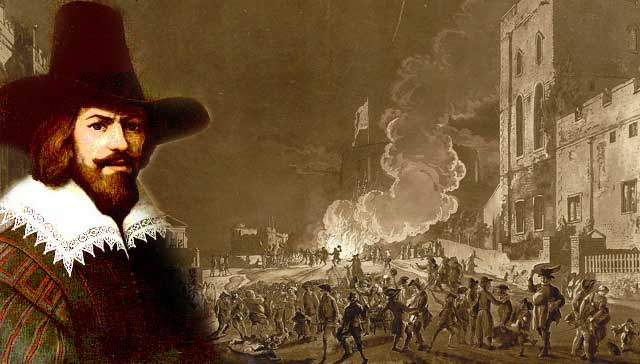Every year in the first week of November, firework displays take place up and down England, from city centre spectaculars to more humble fun in the back garden. This is done in commemoration of a foiled plot to blow up the Houses of Parliament and King James 1 in 1605. It was in fact illegal NOT to celebrate the narrow escape of the Monarch until 1959. Parliament was determined to make an example of the man they caught red handed, waiting in the callers of parliament for the arrival of the King, surrounded by 36 barrels of gun powder with his cloak and spurs on ready to make a swift getaway. This man was Guy Fawkes, born in 1570 in the heart of York.
Guy was born in a house somewhere behind Stonegate. Two plaques in York declare the site of his birthplace, but the exact location is uncertain. He was born into a Protestant family and christened in the church of St Michael le belfry, the church nestled up to the Minster. All its parishioners would have had some connection with the Minster, usually through work. Guy’s father, Edward, was the lawyer.
Guy attended St Peter’s School and made friends with other pupils there, John and Christopher Wright. The Wright brothers came from a family of known recusants-their family had been prosecuted for practising Catholicism. Both John and Christopher later became key players in the Gunpowder plot and it was this friendship made at St Peter’s School which led to Guy’s involvement.
Guy’s father died when he was 10 and his mother remarried Dennis Bainbridge. The Bainbridges were another well known family of recusants. By the time Guy is 16 or 17 there are many Catholic influences in his life and he converts from Protestantism.
Aged around 21, Guy sold everything he owned for a little over £29, and ventured from Yorkshire with his Jesuit priest cousin, Richard Cowling. He traveled to Spain and became a soldier in the Spanish Army. He learnt his trade here a a Sapper. Guy, or Guido, a he became known, acquired the skills of tunnelling, laying gunpowder and creating petards and mines, all of which made him the ideal recruit into the plot to blow up parliament.
In 1604 the plotters rented a house near the Houses of Parliament and here Guy’s skills were put to use. For more than a year, he tunnelled and guarded the precious gunpowder. On the evening of 4th November, the day before King James was due to arrive at Parliament, the cellars were searched. Alerted by by an unusually large pile of firewood, Lord Monteagle, the head of the search party, soon found Guy ready to detonate the deadly arsenal. Conspiracy theories abound on how Lord Monteagle knew where to look and discovered the plot. Many agree that Guy was set up, that some of the plotters were double agents for the government and that the plot had been known about for months.
Guy was duly taken to the tower and ‘racked’, a particularly painful torture involving stretching the body in opposite directions on a wooden rack. He was eventually executed, ironically in the yard of the Palace of Westminster, very close to the Houses of Parliament. Other conspirators were killed or caught, but it is only Guy who is referred to as the devil in the court proceedings and only he whose name became synonymous with the 5th November celebrations.
Today, there is no bonfire St Peter’s School, but it is said that the guys on the bonfires of neighbouring schools are sent to their fiery end wearing a St Peter’s School cap.
So this year, remember, remember the 5th November and spare a thought for poor old Guy Fawkes, the man from York, who may well have set up to fail, as a grisly warning to other would be assassins of the King.
Find out more at www.gunpowder-plot.org or come to York and book a Guy Fawkes tour with a Blue Badge Guide.
Sarah@sarahyorkshireguide.com


